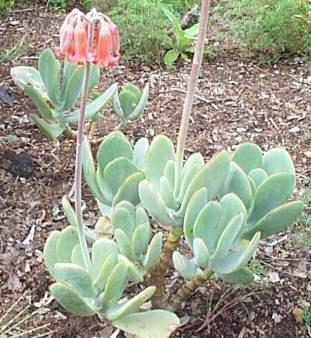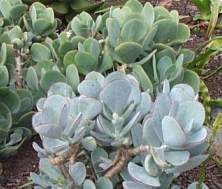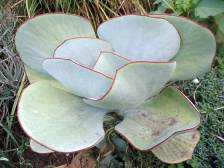Cotyledon orbiculata
Cotyledon orbiculata L.
Family: Crassulaceae
Common names: pig's ears, cotyledon (Eng.); plakkie, platjies, varkoorblare, varkoor, kouterie (Afr.); imphewula (isiXhosa); ipewula (isiZulu)
Introduction
This fast-growing succulent is well known to gardeners, forms a low shrub and adds colour to the winter garden. Forms with handsome grey leaves provide year-round interest in the garden.

Description
Description
This succulent plant has thick leaves which may vary from green to grey, often with a red line around the margin.

Cotyledon orbiculata has five varieties, based on differences in leaf and flower shape. The variability of leaf size, shape and colour is also influenced by the immediate environment. Selected forms in cultivation have been given names such as Elk Horns or Silver Waves.
Flowering time is mostly in winter from June-August, but in the winter rainfall areas such as the Western Cape, it is often in midsummer. The colourful, hanging, tubular/bell-shaped flowers are carried in clusters on the ends of an elongated flower stalk. They are mostly orange-red , but yellow flowering forms are also occasionally found (Ernst van Jaarsveld pers. comm.).
Distribution and habitat
Distribution description
Cotyledon orbiculata is widespread throughout South Africa, but is usually confined to rocky outcrops in grassland, fynbos and karoo regions. Black frost will damage the flowers if planted in an unprotected spot, but the plant itself will tolerate moderate frosts.
Derivation of name and historical aspects
History
The genus name Cotyledon comes from the Greek word kotyledon that means cup-shaped hollow, which refers to the leaves of some species. The species name orbiculata comes from the Latin word meaning round circle.
The name pig's ears is derived from the oval shape of the grey-green leaves of some forms, which are very variable with a red or pale margins.
The genus Cotyledon consists of 10 species in South Africa. Other cotyledons recommended include C. woodii, C. velutina and C. papillaris. Another species, C. tomentosa, is a woolly shrublet with pretty red and yellow, bell-shaped flowers.
Ecology
Ecology
The brightly coloured flowers attract bees and birds, which feed on the nectar of the plant. The silver-grey leaves of some forms owe much of their attractive colouring to a powdery white coating which may assist in reflecting much of the sun's heat to prevent excessive water loss from the thick succulent leaves.
Uses
Use
This is a well-known medicinal plant. The fleshy part of the leaf is applied by many South Africans to soften and remove hard corns and warts. The Southern Sotho use a dried leaf as a protective charm for an orphan child and as a plaything. In the Willowmore District, the heated leaf is used as a poultice for boils and other accessible inflammations, earache in particular .
Van Wyk et al. (1997) report that a single leaf is eaten as a vermifuge and that the warmed juice can be used as drops for toothache or earache. They also report that the juice has been used to treat epilepsy.
Growing Cotyledon orbiculata
Grow
Cotyledon orbiculata is an easy-to-grow plant suitable for a number of places in the garden. It is an ideal plant for the rockery, but also grows well as a pot plant placed on a veranda (stoep). It will also add texture and form to the well-drained flower border. When planted as a pot plant, good drainage is important. It is often found in full sun, but also grows well in semi-shade under trees. This is an ideal plant for the water-wise gardener.

Plants may be grown from seed, but take care in the early stages not to over-water. The best time to sow the seed is in spring, and they should be kept moist, not waterlogged. Once the seedlings have reached 20-40 mm they can be transplanted.
Taking tip cuttings is the fastest method of increasing plant numbers; they must be kept fairly dry to prevent rotting. Once the tip cuttings have rooted they can be transplanted in a medium of 2 parts gravel to 1 part compost.
This plant has few pests, but it may be attacked by snails in the garden.
References
- Cave,Y. 2003. Succulents for the contemporary garden. Timber Press, Portland.
- Dyson, A. 1998. Discovering indigenous healing plants of the herb and fragrance gardens at Kirstenbosch National Botanical Garden. The Printing Press, Cape Town.
- Tölken, H.R. 1985. Crassulaceae. In O.A. Leistner, Flora of southern Africa 14: 1-244. Botanical Research Institute, Pretoria.
- Van Wyk, B-E., Van Oudtshoorn, B. & Gericke, N. 1997. Medicinal plants of South Africa. Briza Publications, Pretoria.
Credits
Shireen Harris
Free State National Botanical Garden
March 2004
With additions by Yvonne Reynolds
Plant Attributes:
Plant Type: Perennial, Succulent
SA Distribution: Eastern Cape, Free State, Gauteng, Limpopo, Mpumalanga, North West, Northern Cape, Western Cape
Soil type: Sandy, Clay, Loam
Flowering season: Late Summer, Autumn, Winter
PH: Acid, Alkaline, Neutral
Flower colour: Red, Yellow, Orange
Aspect: Full Sun, Afternoon Sun (Semi Shade)
Gardening skill: Easy
Special Features:
Horticultural zones










Rate this article
Article well written and informative
Rate this plant
Is this an interesting plant?
Login to add your Comment
Back to topNot registered yet? Click here to register.